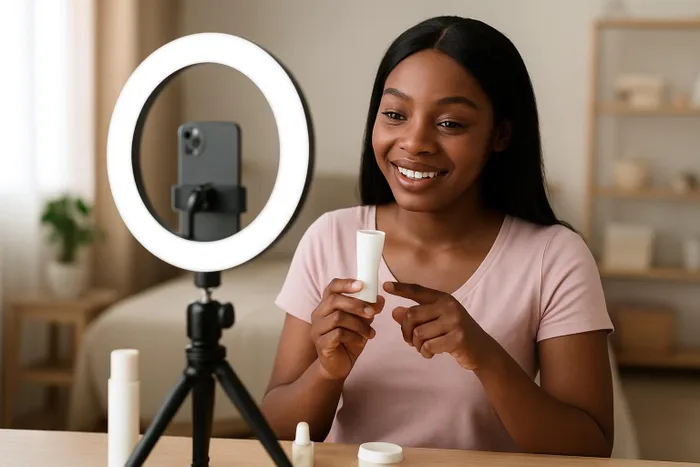Black Friday 2.0: How live commerce is changing shopping in South Africa

A creator hosts a live skincare demo, turning product discovery into a real-time, shoppable moment.
Image: Chatgpt
In South Africa’s fast-evolving retail landscape, Black Friday is no longer just a date - it’s a live storytelling moment. In a world where trust is the new currency and storytelling is the new shelf space, Albert Makoeng - Head of Nfinity’s influencer ecosystem and TheSalt - believes the future of commerce belongs to those who can tell the story, sell the story and turn engagement into experience.
“As consumers, we’ve moved beyond the banner ad,” says Makoeng. “People don’t want to be sold to, they want to see, feel and believe in something before they buy. That’s where creators come in: they turn a deal into a story and a product into a shared moment.”
Across the country, thousands of South Africans are already shopping through livestreams, creator-led “see it, shop it” campaigns; interactive drops that mirror the success of Asia’s live commerce boom. Globally, live shopping (blending real-time video and online buying), is boosting sales between 10%-20%, according to McKinsey, and South Africa is fast catching up.
Makoeng and his team have witnessed the shift firsthand. A shift from “deal first” to “story first”; from “20% off!” to “Here’s why this product solved my problem.” It’s a move that turns discounts into experiences and flash sales into conversations.
In a recent collaboration with Clicks Group, creators transformed what would have been static product placements into authentic, real-time skincare routines, streamed live on social media. Viewers could comment, ask questions and buy instantly.
“It was short, authentic and shoppable. Viewers could literally tap to buy the featured product while watching. When someone you trust says, ‘This actually works on my skin’ while you can see it in action - that’s more powerful than any ad,” says Makoeng.
Where influencer marketing once focused on likes and reach, metric ecosystems such as Nfinity’s, now measure action-based metrics: clicks, add-to-carts, conversions and shares. And the proof is real.
“For Marketers, it’s not enough for a retailer to say ‘20% off.’ It has become vital to create a moment and creators help make that moment relatable,” says Makoeng.
“For creators wanting to rise above the noise through national (even global) retail campaigns, the first port of call is to be trusted and relevant. Smaller creators shouldn’t stress about big budgets. Their advantage is intimacy. Micro-influencers can talk directly to their followers, in their language, about real moments that matter,” adds Makoeng.
Waking up to South Africa’s fast-changing shopping habits is a good start. Makoeng claims that scrolling is no longer how it used to be. Deals no longer live on banners or websites; they arrive live, in-feed and in conversation.
Makoeng pins three of the top shifting patterns in SA’s consumer behaviour:
- Mobile-first discovery: Shoppers find deals through creators, not catalogues.
- Live/scheduled drops: Influencers go live, demo products and answer questions before pointing straight to checkout.
- Community-led trust: Followers buy not because of the biggest discount, but because their creator recommended it.
Black Friday and Beyond
Looking ahead, Makoeng envisions a future where shopping feels more like entertainment than transaction. By 2030, Black Friday will look less like a mad dash and more like a festival of discovery.
“Creators will host mini sales, live drops and community bundles and the sale will be woven into the show, not as an interruption,” says Makoeng.
Whether you’re a micro-influencer or a marketing team building a campaign, the (new) rules of engagement remain the same. Makoeng shares his playbook of 5 quick pivots for this year’s Black Friday success and beyond.
5 Quick Pivots for Brands this Black Friday
- Story First, Deal Second - Lead with your brand’s “why.” Put emotion, real customer problems and authentic experiences at the centre of your messaging, before presenting the offer. A compelling narrative drives stronger brand affinity and higher conversions.
- Remove All Friction - Ensure product links are front and centre. Make sure to simplify your navigation and make checkout as close to one tap as possible. Shopper ease is the most powerful accelerator of purchase intent.
- Create Live Moments - Host livestreams or pop-up digital events that showcase real product results and answer questions in real time. These live touchpoints become high-impact engagement hubs.
- Build Customer Connection - Live shopping works best when it feels like a shared event rooted in community. Encourage interaction by using polls, Q&As and dynamic chat tools to bring shoppers into the experience.
- Follow Up Fast - Momentum drives revenue. After your live moment, be quick to share highlights; thank your audience and showcase top-performing products. Keep the energy going and stay present while the interest is whirlpooling.
Underpinning this evolution is what Nfinity calls ‘social capital’: the trust, credibility and goodwill creators build with their audiences over time. “On Black Friday you can throw every discount in the world at the audience, but if your creator’s community doesn’t believe them, you’ll still fight for every conversion. When someone respects a creator’s voice, their recommendation (social capital) becomes a shortcut past scepticism,” says Makoeng.
Black Friday kicks off on Friday, November 29, 2025.
Related Topics: